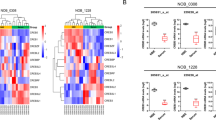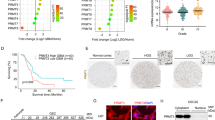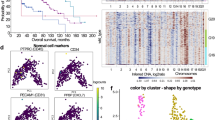Abstract
The concept of cancer stem-like cells (CSCs) has gained considerable attention in various solid tumors including glioblastoma, the most common primary brain tumor. This sub-population of tumor cells has been intensively investigated and their role in therapy resistance as well as tumor recurrence has been demonstrated. In that respect, development of therapeutic strategies that target CSCs (and possibly also the tumor bulk) appears a promising approach in patients suffering from primary brain tumors. In the present study, we utilized RNA interference (RNAi) to screen the complete human kinome and phosphatome (682 and 180 targets, respectively) in order to identify genes and pathways relevant for the survival of brain CSCs and thereby potential therapeutical targets for glioblastoma. We report of 46 putative candidates including known survival-related kinases and phosphatases. Interestingly, a number of genes identified are involved in metabolism, especially glycolysis, such as PDK1 and PKM2 and, most prominently PFKFB4. In vitro studies confirmed an essential role of PFKFB4 in the maintenance of brain CSCs. Furthermore, high PFKFB4 expression was associated with shorter survival of primary glioblastoma patients. Our findings support the importance of the glycolytic pathway in the maintenance of malignant glioma cells and brain CSCs and imply tumor metabolism as a promising therapeutic target in glioblastoma.
This is a preview of subscription content, access via your institution
Access options
Subscribe to this journal
Receive 50 print issues and online access
$259.00 per year
only $5.18 per issue
Buy this article
- Purchase on Springer Link
- Instant access to full article PDF
Prices may be subject to local taxes which are calculated during checkout






Similar content being viewed by others
References
Al-Hajj M . (2007). Cancer stem cells and oncology therapeutics. Curr Opin Oncol 19: 61–64.
Atsumi T, Chesney J, Metz C, Leng L, Donnelly S, Makita Z et al. (2002). High expression of inducible 6-phosphofructo-2-kinase/fructose-2,6-bisphosphatase (iPFK-2; PFKFB3) in human cancers. Cancer Res 62: 5881–5887.
Bao S, Wu Q, McLendon RE, Hao Y, Shi Q, Hjelmeland AB et al. (2006). Glioma stem cells promote radioresistance by preferential activation of the DNA damage response. Nature 444: 756–760.
Brunet A, Park J, Tran H, Hu LS, Hemmings BA, Greenberg ME . (2001). Protein kinase SGK mediates survival signals by phosphorylating the forkhead transcription factor FKHRL1 (FOXO3a). Mol Cell Biol 21: 952–965.
Campos B, Wan F, Farhadi M, Ernst A, Zeppernick F, Tagscherer KE et al. (2010). Differentiation therapy exerts antitumor effects on stem-like glioma cells. Clin Cancer Res 16: 2715–2728.
Christofk HR, Vander Heiden MG, Harris MH, Ramanathan A, Gerszten RE, Wei R et al. (2008). The M2 splice isoform of pyruvate kinase is important for cancer metabolism and tumour growth. Nature 452: 230–233.
Clem B, Telang S, Clem A, Yalcin A, Meier J, Simmons A et al. (2008). Small-molecule inhibition of 6-phosphofructo-2-kinase activity suppresses glycolytic flux and tumor growth. Mol Cancer Ther 7: 110–120.
Eramo A, Ricci-Vitiani L, Zeuner A, Pallini R, Lotti F, Sette G et al. (2006). Chemotherapy resistance of glioblastoma stem cells. Cell Death Differ 13: 1238–1241.
Ernst A, Hofmann S, Ahmadi R, Becker N, Korshunov A, Engel F et al. (2009). Genomic and expression profiling of glioblastoma stem cell-like spheroid cultures identifies novel tumor-relevant genes associated with survival. Clin Cancer Res 15: 6541–6550.
Fischer C, Mazzone M, Jonckx B, Carmeliet P . (2008). FLT1 and its ligands VEGFB and PlGF: drug targets for anti-angiogenic therapy? Nat Rev Cancer 8: 942–956.
Floridi A, Paggi MG, Fanciulli M . (1989). Modulation of glycolysis in neuroepithelial tumors. J Neurosurg Sci 33: 55–64.
Giroux V, Iovanna J, Dagorn JC . (2006). Probing the human kinome for kinases involved in pancreatic cancer cell survival and gemcitabine resistance. FASEB J 20: 1982–1991.
Gomez-Brouchet A, Pchejetski D, Brizuela L, Garcia V, Altie MF, Maddelein ML et al. (2007). Critical role for sphingosine kinase-1 in regulating survival of neuroblastoma cells exposed to amyloid-beta peptide. Mol Pharmacol 72: 341–349.
Gomez M, Manzano A, Navarro-Sabate A, Duran J, Obach M, Perales JC et al. (2005). Specific expression of pfkfb4 gene in spermatogonia germ cells and analysis of its 5′-flanking region. FEBS Lett 579: 357–362.
Heddleston JM, Li Z, McLendon RE, Hjelmeland AB, Rich JN . (2009). The hypoxic microenvironment maintains glioblastoma stem cells and promotes reprogramming towards a cancer stem cell phenotype. Cell Cycle 8: 3274–3284.
Hsu PP, Sabatini DM . (2008). Cancer cell metabolism: Warburg and beyond. Cell 134: 703–707.
Kasahara Y, Tuder RM, Taraseviciene-Stewart L, Le Cras TD, Abman S, Hirth PK et al. (2000). Inhibition of VEGF receptors causes lung cell apoptosis and emphysema. J Clin Invest 106: 1311–1319.
Keith B, Simon MC . (2007). Hypoxia-inducible factors, stem cells, and cancer. Cell 129: 465–472.
Kessler R, Eschrich K . (2001). Splice isoforms of ubiquitous 6-phosphofructo-2-kinase/fructose-2,6-bisphosphatase in human brain. Brain Res Mol Brain Res 87: 190–195.
Kress S, Stein A, Maurer P, Weber B, Reichert J, Buchmann A et al. (1998). Expression of hypoxia-inducible genes in tumor cells. J Cancer Res Clin Oncol 124: 315–320.
Lee J, Kotliarova S, Kotliarov Y, Li A, Su Q, Donin NM et al. (2006). Tumor stem cells derived from glioblastomas cultured in bFGF and EGF more closely mirror the phenotype and genotype of primary tumors than do serum-cultured cell lines. Cancer Cell 9: 391–403.
Liu G, Yuan X, Zeng Z, Tunici P, Ng H, Abdulkadir IR et al. (2006). Analysis of gene expression and chemoresistance of CD133+ cancer stem cells in glioblastoma. Mol Cancer 5: 67.
Lu H, Forbes RA, Verma A . (2002). Hypoxia-inducible factor 1 activation by aerobic glycolysis implicates the Warburg effect in carcinogenesis. J Biol Chem 277: 23111–23115.
MacKeigan JP, Murphy LO, Blenis J . (2005). Sensitized RNAi screen of human kinases and phosphatases identifies new regulators of apoptosis and chemoresistance. Nat Cell Biol 7: 591–600.
Manzano A, Rosa JL, Ventura F, Perez JX, Nadal M, Estivill X et al. (1998). Molecular cloning, expression, and chromosomal localization of a ubiquitously expressed human 6-phosphofructo-2-kinase/ fructose-2, 6-bisphosphatase gene (PFKFB3). Cytogenet Cell Genet 83: 214–217.
Michelakis ED, Sutendra G, Dromparis P, Webster L, Haromy A, Niven E et al. (2010). Metabolic modulation of glioblastoma with dichloroacetate. Sci Transl Med 2: 31ra34.
Minchenko O, Opentanova I, Minchenko D, Ogura T, Esumi H . (2004). Hypoxia induces transcription of 6-phosphofructo-2-kinase/fructose-2,6-biphosphatase-4 gene via hypoxia-inducible factor-1alpha activation. FEBS Lett 576: 14–20.
Okuyama H, Krishnamachary B, Zhou YF, Nagasawa H, Bosch-Marce M, Semenza GL . (2006). Expression of vascular endothelial growth factor receptor 1 in bone marrow-derived mesenchymal cells is dependent on hypoxia-inducible factor 1. J Biol Chem 281: 15554–15563.
Pardal R, Clarke MF, Morrison SJ . (2003). Applying the principles of stem-cell biology to cancer. Nat Rev Cancer 3: 895–902.
Park CY, Tseng D, Weissman IL . (2009). Cancer stem cell-directed therapies: recent data from the laboratory and clinic. Mol Ther 17: 219–230.
Pradelli LA, Beneteau M, Chauvin C, Jacquin MA, Marchetti S, Munoz-Pinedo C et al. (2010). Glycolysis inhibition sensitizes tumor cells to death receptors-induced apoptosis by AMP kinase activation leading to Mcl-1 block in translation. Oncogene 29: 1641–1652.
Reya T, Morrison SJ, Clarke MF, Weissman IL . (2001). Stem cells, cancer, and cancer stem cells. Nature 414: 105–111.
Sakata J, Abe Y, Uyeda K . (1991). Molecular cloning of the DNA and expression and characterization of rat testes fructose-6-phosphate,2-kinase:fructose-2,6-bisphosphatase. J Biol Chem 266: 15764–15770.
Singh SK, Clarke ID, Terasaki M, Bonn VE, Hawkins C, Squire J et al. (2003). Identification of a cancer stem cell in human brain tumors. Cancer Res 63: 5821–5828.
Soeda A, Park M, Lee D, Mintz A, Androutsellis-Theotokis A, McKay RD et al. (2009). Hypoxia promotes expansion of the CD133-positive glioma stem cells through activation of HIF-1alpha. Oncogene 28: 3949–3959.
Stupp R, Hegi ME, Gilbert MR, Chakravarti A . (2007). Chemoradiotherapy in malignant glioma: standard of care and future directions. J Clin Oncol 25: 4127–4136.
Toedt G, Barbus S, Wolter M, Felsberg J, Tews B, Blond F et al. (2011). Molecular signatures classify astrocytic gliomas by IDH1 mutation status. Int J Cancer 128: 1095–1103.
Vescovi AL, Galli R, Reynolds BA . (2006). Brain tumour stem cells. Nat Rev Cancer 6: 425–436.
Wigfield SM, Winter SC, Giatromanolaki A, Taylor J, Koukourakis ML, Harris AL . (2008). PDK-1 regulates lactate production in hypoxia and is associated with poor prognosis in head and neck squamous cancer. Br J Cancer 98: 1975–1984.
Wurdak H, Zhu S, Romero A, Lorger M, Watson J, Chiang CY et al. (2010). An RNAi screen identifies TRRAP as a regulator of brain tumor-initiating cell differentiation. Cell Stem Cell 6: 37–47.
Yalcin A, Telang S, Clem B, Chesney J . (2009). Regulation of glucose metabolism by 6-phosphofructo-2-kinase/fructose-2,6-bisphosphatases in cancer. Exp Mol Pathol 86: 174–179.
Zimmerman DW, Zumbo BD . (1993). Rank transformations and power of the Student t test and Welch t test for nonnormal populations with unequal variances. Can J Exp Psychol 47: 523–539.
Acknowledgements
We thank Dr S Pfister and D Haag for their helpful comments. We thank Mrs V Lang and G Iren for their technical help. We thank Dr J Chesney for kindly providing 3PO. This work was supported by the German Federal Ministry of Education and Research (BMBF) within the National Genome Research Network (NGFNplus; 01GS0883, 01GS0884), a stipend from the Alexander von Humboldt foundation (to SN) and by the grant ‘Young Investigator Fellowship’ of the Medical Faculty of Heidelberg (to VG).
Author information
Authors and Affiliations
Corresponding author
Ethics declarations
Competing interests
The authors declare no conflict of interest.
Additional information
Supplementary Information accompanies the paper on the Oncogene website
Rights and permissions
About this article
Cite this article
Goidts, V., Bageritz, J., Puccio, L. et al. RNAi screening in glioma stem-like cells identifies PFKFB4 as a key molecule important for cancer cell survival. Oncogene 31, 3235–3243 (2012). https://doi.org/10.1038/onc.2011.490
Received:
Revised:
Accepted:
Published:
Issue Date:
DOI: https://doi.org/10.1038/onc.2011.490
Keywords
This article is cited by
-
Comparative clinical significance and biological roles of PFKFB family members in oral squamous cell carcinoma
Cancer Cell International (2023)
-
Differential roles of highly expressed PFKFB4 in colon adenocarcinoma patients
Scientific Reports (2023)
-
THOC3 interacts with YBX1 to promote lung squamous cell carcinoma progression through PFKFB4 mRNA modification
Cell Death & Disease (2023)
-
The role of ROS in tumour development and progression
Nature Reviews Cancer (2022)
-
Metabostemness in cancer: Linking metaboloepigenetics and mitophagy in remodeling cancer stem cells
Stem Cell Reviews and Reports (2022)



